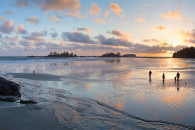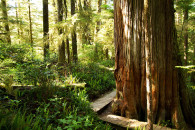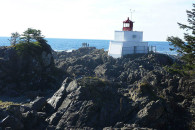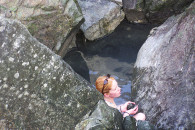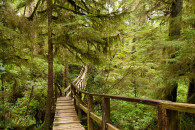10 Cool Things You May Not Notice But Are Important to a Tofino Rainforest!
1. Banana Slugs
The banana slug is the largest slug in the world. It can from to 20 cm (9 inches) long and tip the scales at 120 g (1/4 lb.). Feeding on lichens, mushrooms and herbs, it slides along on a trail of slime dribbled from its chin. Watch for these cool slugs cruising by in a Tofino Rainforest. You'll know then for sure because they are yellow slugs that do look like a small banana.
2. Dwarf Mistletoe
Dwarf Mistletoe, a parasitic plant, can fire its sticky seeds up to 15 meters! They land on nearby hemlocks and extend feeder roots into the living host. Affected trees develop clumps of spoke-like branches. Keep your eyes peeled for this tricky mistletoe in the Tofino Rainforests.
3. Epiphytes
Overhead in the forest clumps of mosses, lichens and ferns festoon the branches and trunks of rainforest trees. These epiphytes(Greek for "upon a plant") do not send feeder roots into the living tissue of their host. Instead, they depend on nutrients borne by the wind and moisture from rain and condensed fog.
At least 100 species of epiphytes live on these trees, each fine-tuned to available light, temperature and moisture. Sun-loving beard lichens encrust upper branches while streamer of thread moss drape lower branches. A single tree in a Tofino Rainforest may bear a load of 25kg of epiphytes.
4. Fallen Trees/Nurse Logs
Many of the trees in this forest, including three quarters of all the hemlocks, started life on fallen trees that became rotted logs. Lines of mature trees may indicate a common beginning on a single nurse log. Hemlock saplings are nourished by nutrients released as the wood rots. Inside the log, the intense activity of decay fungi and bacteria raises the temperature a few degrees, stimulating the growth of tree roots. Gradually they inch around the log and touch the ground. After 100 years only one out of 1000 original seedlings may remain.
The rotting wood seethes with activity. Pseudo-scorpions stalk along dark tunnels, salamander eggs stir and hatch and mites nibble fungus. At the peak of decay, a rotting log harbours more organisms than there are people on earth.
5. The Forest Floor
Only 5 to 10% of sunlight striking the canopy reaches the ground floor, but that's just enough for the shrubs to run rampant. Deceived by this lush undergrowth, early settlers had visions of radishes as big as pumpkins. Unfortunately, most of their crops withered in the acidic, nutrient-poor soil.
Unlike crop plants, shrubs like salal, false azalea and huckleberry can absorb essential nitrogen in the form of ammonia - present in very acidic soils. Over thousands of years they have adapted to conditions other plants cannot tolerate.
6. The Ground Soil
The soil - a world of perpetual night where miniature life forms roam a maze of roots, soil particles and rotting wood. The surface layer, a thick mat of decaying plant and animal matter, is the food bank of the rainforest community. But it doesn't release its wealth easily. Material rots slowly in this acidic soil and heavy rains carry nutrients deep beyond the reach of many plant roots.
Soil fungi thrive in acidic conditions. A thimbleful of soil may contain several kilometres of microscopic fungal threads. These are grazed on by mites and springtails, consumed in turn by larger organisms. The health of the entire forest depends on this ballet of interaction beneath out feet.
7. Shady Plants
Shady Plants in Tofino Rainforests include Deer fern, Salal and False Lily of the valley.
Plants adapted to deep shade often have large flat leaves designed to intercept as much light as possible. These richly coloured leaves are crammed with chlorophyll, the green pigment all plants use to capture the energy of sunlight.
8. Small Mammals
The sweet little Deer mouse is a small mammal of a Tofino Rainforest.
Small Mammals eat the fruiting bodies of underground fungi and later deposit the undigested spores on log runways. The spores produce masses of tiny threads that wrap around the roots of conifer seedlings, helping them absorb nutrients while receiving sugars in return.
9. Snags
Snags serve as multilevel apartments, providing food and shelter for thousands of animal tenants. As a tree starts to decay, nuthatches patrol the trunk, chipping off flakes of bark in search of insects. After the bark sloughs off, the pileated woodpecker chisels out a nest cavity. To feed its young, it drills rectangular holes into dead trees, plucking out juicy ants and termites. In turn, abandoned woodpecker holes provide homes for squirrels and raccoons. Thus, snags and the insects that invade them, continue to support the life of the forest.
10. Streams
In this forest, rain sets the theme. Dripping off leaves and trickling down trunks, a life-line of water flows through the community. Small streams, stained brown from tannins released from rotting cedar, provide habitat for some rarely seen forest residents.
The stream's load of wood provides food for insects and cover for small fish. In the spring, when the skink cabbage bursts into bloom, the red-legged frog gives its mating call underwater. Rarely is it heard over the chorus of tree frogs breeding at the same time. The northwestern salamander inhabits moist crannies on land, but breeds in pools, laying clumps of eggs around submerged twigs.
Small groups of spawning adult salmon swim up fresh water streams when it is swollen by autumn rains.
11. Bonus Thing! Tropical vs Temperate
A temperate rainforest, such as Tofino Rainforests, has fewer different species than its tropical counter-part, but may contain the greatest weight of living organisms per area of any ecosystem on earth. As you hike through the rainforest trails in Tofino you are part of a great ecosystem that has been living for thousands of years. Feel it, breathe it in and it will always be a part of you.

